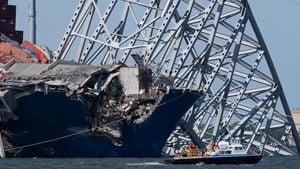With the world increasingly focused on clean energy solutions to combat climate change, the renewed interest in nuclear power has garnered attention from officials and scientists alike. Various initiatives are underway to develop next-generation nuclear power plants across the United States, with numerous sites being scrutinized for their viability.
One of the most exciting developments is focused on Nebraska, where sixteen sites are currently being evaluated as potential locations for state-of-the-art nuclear power facilities. The Nebraska Public Power District (NPPD), which operates the state’s only nuclear plant at Cooper Nuclear Station, has initiated the process of identifying these sites. According to officials, this move reflects a broader ambition to explore nuclear energy's role as part of the solution to future energy needs.
"Nuclear power is considered a critical tool for reducing greenhouse gas emissions, alongside role-playing clean energy sources like wind and solar," stated NPPD CEO, Tom Kent. The state is optimistic about this approach, especially as the country pushes toward legislation aimed at developing advanced reactor technologies. This isn't just about wanting to adopt the technology but also ensuring the sites selected align with safety regulations and community benefits.
On the broader national stage, there’s significant momentum around advancing nuclear technology. President Joe Biden’s administration has fast-tracked regulations involved with even getting new reactors approved and operational. This is primarily geared toward expediting the construction of small modular reactors (SMRs) and innovative advanced reactors, which promise increased safety and efficiency. For example, advanced reactors might use helium or liquid metal as coolants instead of the traditional water, which could allow them to operate at low pressures and reduce risk factors typically seen with high-pressure systems.
TerraPower, co-founded by Bill Gates, stands at the forefront of this revolution, seeking to usher the nation’s first advanced reactor capability. Their project, which has been seeking permits for the last few months, aims to be operational by 2030. This kind of commitment is emblematic of the industry's push; supporters advocate these updates are not just beneficial—they're necessary, especially within the context of climate change.
One prevalent question surrounding these advancements involves the safety of next-generation reactors. Many are understandably cautious, recalling high-profile nuclear incidents of the past. The Nuclear Regulatory Commission (NRC) emphasizes, though, the new reactors are built with rigorous safety standards. According to NRC spokesman Scott Burnell, these reactors must demonstrate their capability to safely shut down and keep fuel secure, even during severe weather or other emergencies. New designs introduced may utilize natural forces like gravity or convection for cooling, setting them apart from their predecessors.
Critics remain skeptical, with fears tied to the potential for radioactive waste from these advanced facilities. Currently, spent nuclear fuel from conventional reactors is stored at over seventy sites across the U.S., typically secured within concrete pools or dry storage casks. The Acting Assistant Secretary for Nuclear Energy, Michael Goff, explained the new designs will abide by the same waste management protocols, pledging efforts will be made to not only safely store spent fuel but also explore avenues for recycling it.
Countries like France have set precedents by reprocessing their nuclear waste, aiming to reuse elements like uranium and plutonium. Although the U.S. doesn’t currently have active operations for this, Goff pointed out plans are underway to potentially integrate some aspects of waste reuse within the advanced reactor designs. This highlights another layer of innovation intended to make nuclear energy cleaner and more sustainable.
Simultaneously, the path forward does not come without challenges. The timeline for getting new reactors online has been another point of contention for the general public. Established projects have significantly underestimated the time and budget required to complete successful construction. Efforts to push TerraPower’s construction permit through will face inevitable scrutiny, but if successful, it could usher the U.S. to the frontier of nuclear technology.
Looking beyond just Nebraska, several regions across America are beginning to contend with the advantages of nuclear capabilities. For example, the Midwest is touted for its favorable conditions like proximity to water sources necessary for cooling and pre-existing workforce infrastructure. On the other hand, community buy-in will be integral, necessitating cooperation between organizations, local governments, and citizens during development.
Across the ocean, Russia and China lead the pack with operational advanced reactors, demonstrating the global race toward utilizing nuclear power as a solution for carbon-free electricity generation. The stakes are high to position the United States prominently within this race. The combined efforts of the Biden administration and private sectors signify the importance of renewing interest and commitment to advancing nuclear technologies.
Ali Zaidi, White House National Climate Advisor, elaborated on the necessity of revolutionizing nuclear power plants beyond just clean energy aspirations.
"The world has to feed future energy needs with sustainable solutions," Zaidi remarked. He emphasized the urgency, stating, "We’re finding ourselves at the decisive decade for climate action. It’s incumbent on us to pull every tool off the sidelines and leverage these technologies as we race toward sustainable future energy solutions."
The narrative surrounding next-generation nuclear power plants is evolving. With the persistent innovations and regulatory advancements, shifting perceptions of nuclear energy may pave the way for broader acceptance. Lies down the path often witness challenges, but the collective narrative may just be punctuated by progress toward energy sustainability.
While uncertainties abound—from management of nuclear waste to potential safety risks—the commitment to cleaner energy through advanced nuclear technology remains ambitious. The hope is positioned on the advancements of these sites and their associated technologies leading to safe, efficient, and sustainable energy generation, bridging the gap between the past and the future of energy consumption.



